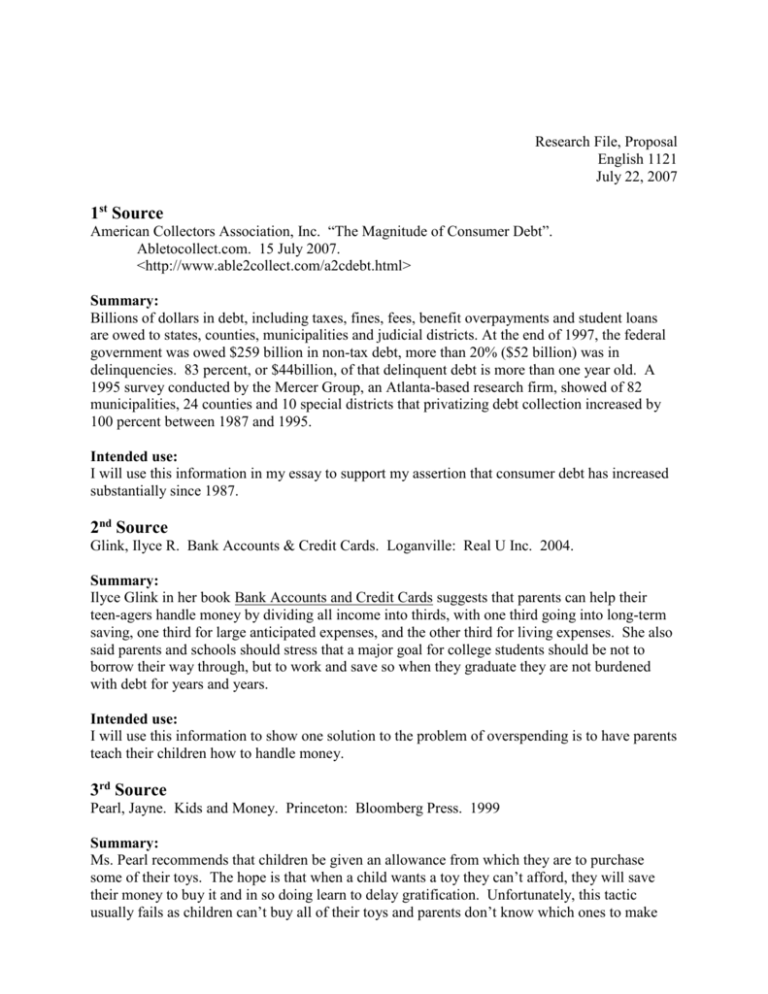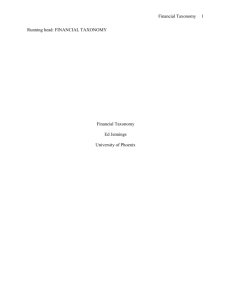sample - Anoka Ramsey Community College
advertisement

Research File, Proposal English 1121 July 22, 2007 1st Source American Collectors Association, Inc. “The Magnitude of Consumer Debt”. Abletocollect.com. 15 July 2007. <http://www.able2collect.com/a2cdebt.html> Summary: Billions of dollars in debt, including taxes, fines, fees, benefit overpayments and student loans are owed to states, counties, municipalities and judicial districts. At the end of 1997, the federal government was owed $259 billion in non-tax debt, more than 20% ($52 billion) was in delinquencies. 83 percent, or $44billion, of that delinquent debt is more than one year old. A 1995 survey conducted by the Mercer Group, an Atlanta-based research firm, showed of 82 municipalities, 24 counties and 10 special districts that privatizing debt collection increased by 100 percent between 1987 and 1995. Intended use: I will use this information in my essay to support my assertion that consumer debt has increased substantially since 1987. 2nd Source Glink, Ilyce R. Bank Accounts & Credit Cards. Loganville: Real U Inc. 2004. Summary: Ilyce Glink in her book Bank Accounts and Credit Cards suggests that parents can help their teen-agers handle money by dividing all income into thirds, with one third going into long-term saving, one third for large anticipated expenses, and the other third for living expenses. She also said parents and schools should stress that a major goal for college students should be not to borrow their way through, but to work and save so when they graduate they are not burdened with debt for years and years. Intended use: I will use this information to show one solution to the problem of overspending is to have parents teach their children how to handle money. 3rd Source Pearl, Jayne. Kids and Money. Princeton: Bloomberg Press. 1999 Summary: Ms. Pearl recommends that children be given an allowance from which they are to purchase some of their toys. The hope is that when a child wants a toy they can’t afford, they will save their money to buy it and in so doing learn to delay gratification. Unfortunately, this tactic usually fails as children can’t buy all of their toys and parents don’t know which ones to make them save for and which ones to buy for them. There is also the crying/howling factor in the store when a child carries on until their parents give in and get them what they want “just this time”. Intended use: I will use this information to show that giving children an allowance to help them manage money does not always work for a variety of reasons. . 4th Source Stein, Robin. “The Ascendancy of the Credit Card Industry”. 23 Nov. 2004. PBS.org. 15 July 2007. <http://www.pbs.org/wgbh/pages/frontline/shows/credit/more/rise.html> Summary: According to Robin Stein, as the years passed and banks and corporations who own credit card companies got greedier, they discovered a little noticed gem in a 1978 Supreme Court decision. This decision permitted national banks to charge whatever percent of interest was permitted by the state where they were incorporated. Twenty-six states have no limit on interest rates. Intended use: I will use this information to show that a Supreme Court decision was the catalyst for credit card companies to begin charging previously unheard of interest rates, which lead to their no longer analyzing the credit worthiness of the card holders. The least credit worthy were likely to run up the largest debt and make them richer. 5th Source Dunleavey, MP. “How Teens Get Sucked Into Credit Card Debt”. July 2007. MSN Money. 22 July 2007. <http://articles.moneycentral.msn.com/SavingandDebt/ManageDebt/HowTeensGetSucke dIntoCreditCardDebt.aspx> Summary: Children who are not yet old enough to drive are receiving credit card offers that are coaddressed to parents while they are still living at home. Author Janet Bodnar said she didn’t think it was healthy for teenager to have credit cards before college. She said she does think giving young people credit cards teaches them financial responsibility. She said most kids have a hard time getting a school paper in on time, much less paying a credit card bill. She said credit cards are like “funny money” to young people. It doesn’t feel like real money and is like a license to spend. 6th Source Walker, Rob. “The Cover Of Money”. 27 May 2007. The New York Times. 22 July 2007. <http://www.nytimes.com/2007/05/27/magazine/27wwln-consumedt.html?ex=1185249600&en=8d3bf845e79f0716&ei=5070> Summary: The Federal Reserve Bank’s most recent figures showed an increase of more than nine percent in credit card debt, putting the total at $888.2 million as of March 2007. This is debt carried by millions of consumers who fail to pay off their charges monthly, but let them revolve from 2 month to month. Shockingly, some consumers see this debt as an emblem of which to be proud and are ordering “skins” with special designs to stick on the front of their credit cards as a unique identifying sign. An enterprising company called CreditCovers is selling these skins. 7th Source Bond, Patti. “I want Barney!': TV turns kids into grocery cart potatoes”. 8 August 2006. The Atlanta Journal – Constitution. 22 July 2007. <http://proquest.umi.com/pqdweb?index=0&did=1090737421&SrchMode=1&sid=1&F mt=3&VInst=PROD&VType=PQD&RQT=309&VName=PQD&TS=1160580643&clien tId=43987&cfc=1> Summary: Wal-Mart and Texas chain H-E-B are testing a new idea in tending to children while shopping. For the price of $1.00 per trip, they are offering parents the use of a battery operated T.V. that will be placed in your shopping cart to entertain the children while shopping. 2,000 carts have already been installed in these stores in the U.S. Other companies are also trying this new marketing technique. 8th Source “Giving Credit Its Due; Target Won’t Sell Its Lucrative Cash Cow”. 19 July 2007. Columbia Daily Tribune. 22 July 2007 <http://proquest.umi.com/pqdweb?index=2&did=1307132761&SrchMode=1&sid=1&F mt=3&VInst=PROD&VType=PQD&RQT=309&VName=PQD&TS=1185151783&clien tId=43987> Summary: Target’s $6.7 billion credit card business accounts for almost 15 percent of their pretax profit. They are the seventh-largest issuer of credit cards, with 17.8 million in accounts, higher even than Wells Fargo Bank’s credit card business. Investors are nervous about so much of Target’s revenue coming from credit cards during this time of increasing mortgage defaults and higher interest rates squeezing consumers. There is concern that a nationwide credit problem is heading our way, in which case Target could suffer huge losses. There are a growing number of financial and retail analysts strongly suggesting that Target sell its credit card business and invest the more than $1 billion in proceeds in its stores. 3











